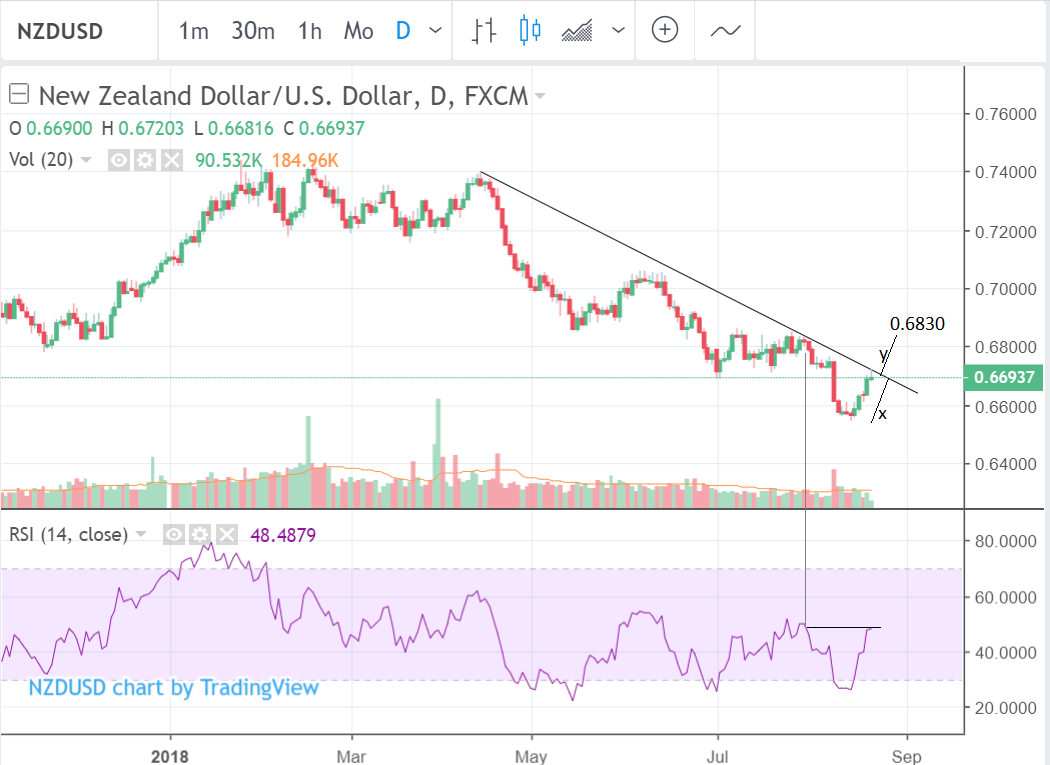New Zealand Dollar Reaches Key Technical Level after Strong Retail Data but Where Next?
- NZD/USD rises to major trendline but can it break through?
- An upside breakout would mark beginning of a bullish trend.
- But analysts are pessimistic, fundamentals suggest lower NZD.

© Rafael Ben-Ari, Adobe Stock
The New Zealand reached a key 'make-or-break' technical level against the US Dollar Wednesday but chart signals of what might happen next are mixed, analysts are pessimistic in their outlook and the Kiwi's fundamentals are weak.
At 0.6700, the NZD/USD has reached a pivotal level that could see it breakout higher into a new and bullish trend, or give way to fresh losses.

Above: NZD/USD rate shown at daily intervals.
The 0.67 level coincides with a neat trendline drawn from the April peak. If the market breaks out above this level, a move that would be confirmed by a push above 0.6735, a bullish rally to the 0.6830 level could ensue.
Supporting the notion of further upside for NZD/USD is the Relative Strength Index (RSI) momentum indicator, featured in the lower pane of the below chart, which has risen strongly during the recent rebound. This suggests the recovery could very well continue.

Above: NZD/USD chart showing upturn in the Relative Strength Index.
The RSI has reached 48, a level last seen in July when the market was well above 0.68, which further suggests more upside is in the cards.
The pair rose up and touched the same trendline in July, however, and was repulsed from it. So there is a precedent that could also see the exchange rate turned back from current levels.

Above: NZD/USD chart showing "sell zone" between 10 and 20 period moving averages.
Contradicting this, however, is the fact the exchange rate has now broken out of the 'sell zone' between the 10 and 20 period moving averages (MA). Some traders say is the optimum place to rejoin a downtrend. Again this is a bullish sign.
The up-move overnight was driven retail sales data that showed a surprise 1.1% increase in consumer spending during the second quarter. This was up from an upwardly-revised 0.3% previously and a country mile ahead of the consensus for growth of just 0.4%.
The actual growth number was more than 30% higher than even the most optimistic economist forecast, which was for sales growth of 0.8%, nevertheless, some analysts remained sceptical of the follow-through potential for NZD off the back of the data surprise.
"This print gave a tailwind to the NZD but we don't expect this to be sustained, even though we remain more constructive on the economy than the RBNZ and consensus. The RBNZ is simply offering no incentive to hold NZD just now," says Annette Beacher, chief Asia Pacific macro strategist at TD Securities.
The Reserve Bank of New Zealand has held its interest rate at a record low of 1.75% ever since late 2016. But recent weeks have seen analysts begin to speculate the bank might cut the cash rate in order to bolster the economy and stoke inflation, which remains stubbornly below the midpoint of the RBNZ's 1% to 3% target.
Such a cut in interest rates would weigh on the New Zealand Dollar (Kiwi) since lower interest rates would reduce foreign capital inflows and lure speculators into bearish bets against the currency. There are already signs that banks operating in the mortgage market are gearing up for an RBNZ rate cut.
"The major banks are already moving, i.e. Westpac shaved 60bp off its 5y mortgage rate to 4.99%. Also, Kiwibank is cutting 20bp from its 1yr "special" mortgage rate, dropping it to 3.99%, from Monday," Beacher writes, in a briefing for clients last week.
Up until now the RBNZ has said it will hold interest rates at their current levels until well into the 2020 year. But exactly what it actually does will depend on the outcome of trade talks between China and the US as well as developments in the domestic economy. China is New Zealand's largest trade partner.
Get up to 5% more foreign exchange by using a specialist provider to get closer to the real market rate and avoid the gaping spreads charged by your bank when providing currency. Learn more here




